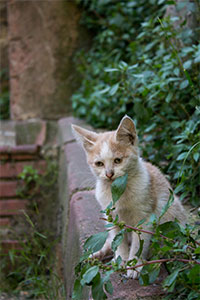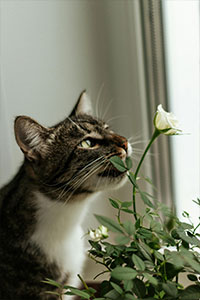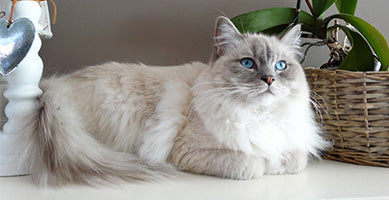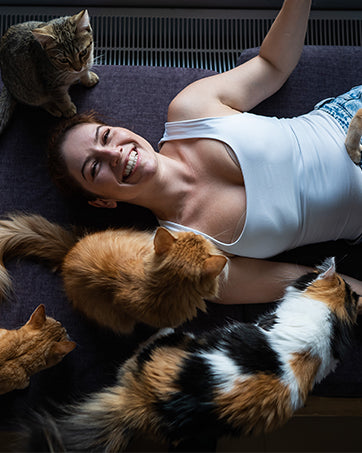Jessica W. Kelvin - Mar.05.2024
Why Do Cats Eat Grass?
7 Insights into Feline Behavior

Why Is My Cat Losing Hair?
Est. read time: 6 min.
The Science Behind Shedding
UShedding in cats is much more than just a superficial nuisance; it's an essential biological process rooted deeply in their physiology. Understanding this can help cat owners appreciate the complexities of their pets and manage shedding more effectively.
Natural Cycle of Hair Growth
Cats' hair goes through a life cycle that includes growth, rest, and shedding phases. This cycle is influenced by several factors, including hormonal changes, day length, and temperature. In the wild, shedding is heavily influenced by the seasons, with cats typically shedding more as the days get longer in spring to lose their winter coat. However, indoor cats, influenced by artificial lighting and controlled temperatures, may shed more uniformly throughout the year.
Breed Specificity
The breed of your cat also plays a significant role in shedding patterns. Some breeds, like Siamese or Sphynx, are known for minimal shedding due to their coat characteristics, while others, such as Maine Coons or Persians, shed more due to their long fur. Understanding your cat's breed-specific shedding patterns can help in adopting appropriate grooming techniques.
Health and Nutrition
Shedding is not just a matter of physical appearance but can also be an indicator of a cat's overall health. A healthy diet rich in omega-3 fatty acids, for instance, can promote healthier skin and fur, reducing excessive shedding. Conversely, a diet lacking in essential nutrients may lead to increased shedding and even skin problems.
Additionally, shedding can sometimes signal underlying health issues. A sudden increase in shedding, accompanied by skin irritation or other symptoms, may necessitate a visit to the veterinarian to rule out allergies, parasitic infections, or other health concerns.
Understanding these scientific aspects of shedding can transform how we perceive this phenomenon—from a mere inconvenience to an important indicator of our cats’ health and well-being. With this knowledge, cat owners can better tailor their care strategies to suit their furry companions’ needs.

Factors Influencing Shedding
While shedding is a natural process, several factors can influence its extent and frequency. Understanding these can help cat owners manage shedding more effectively and ensure their pets remain comfortable and healthy.
Diet and Nutrition
The saying "you are what you eat" holds true for cats as well. A diet lacking in essential nutrients, particularly omega-3 and omega-6 fatty acids, can lead to dry skin and increased shedding. Conversely, high-quality cat foods that are rich in these nutrients can promote healthier skin and reduce unnecessary shedding. Hydration is also crucial; a well-hydrated cat will have healthier skin, which can mitigate excessive shedding.
Cats:Theobromine Toxic Consumption
Most Cats: 1-10 lbs(0.45-4.6 kg), Large Cats11-25 lbs(5-11.4 kg)
Cacao Beans: Most Cats> 0.05 oz, Large Cats> 0.5 0z
Unsweetened Baking Chocolate: Most Cats> 0.2 oz, Large Cats>2 0z
Dark Chocolate: Most Cats> 0.5 0z, Large Cats>7 oz
Milk Chocolate: Most Cats>1.5 0z, Large Cats>16.5 0Z
White Chocolate: Most Cats>360 oz, Large Cats>4000 0z
Cocoa Powder: Most Cats> 01 0z, Large Cats>10z
Cocoa Bean Mulch: Most Cats>0.1 0z, Large Cats>1 0z

Showing making procedure is a good way to guarantee product quality
Stress Relief
Eating grass can also serve as a form of stress relief for cats, providing a calming activity that distracts from anxiety or boredom.


Get customer attention by clean visual and video
Instinctual Actions
Grass eating is an instinctual behavior that may stem from a cat's need to seek out alternative food sources or to induce vomiting to clear their stomachs of indigestible materials.
Stress and Environment
Cats are sensitive creatures, and stress can have a significant impact on their physical health, including their shedding patterns. Changes in the environment, such as moving to a new home, the arrival of a new pet, or even changes in the household routine, can stress your cat and lead to increased shedding. Creating a stable, stress-free environment can help minimize stress-induced shedding.
Seasonal Changes
As previously mentioned, shedding can be influenced by the change of seasons, particularly for cats with access to the outdoors. However, indoor cats are not immune to seasonal changes; variations in indoor lighting and heating can also affect their shedding cycles. Understanding these patterns can help prepare pet owners for periods of increased shedding.
Article credit: Heidi Cohen (https://heidicohen.com/use-blog-to-sell/)
Digestive Aid
Grass acts as a natural laxative, helping cats pass hairballs or other indigestible items through their digestive tract more easily.
Elimination of Parasites
It's also theorized that grass eating may help cats eliminate intestinal parasites, although this benefit is more anecdotal than scientifically proven.
Age and Health
Younger and older cats may experience different shedding patterns due to their developmental and health status. Additionally, health issues, such as skin infections, allergies, or systemic diseases, can significantly impact a cat's shedding. Regular veterinary check-ups can help identify and manage health-related shedding issues.
By paying attention to these factors, cat owners can better understand and manage their feline friends' shedding. This not only helps in maintaining a cleaner home but also contributes to the overall well-being of their beloved pets.
Managing Shedding
Managing your cat's shedding is not just about keeping your home hair-free; it's also about ensuring your cat's comfort and health. Here are some practical ways to manage shedding effectively.
Regular Grooming
Regular brushing is the cornerstone of managing shedding. For short-haired breeds, brushing a few times a week can suffice, while long-haired cats may require daily grooming to prevent matting and reduce shedding. Using the right tools, such as a de-shedding brush or glove, can make this process more efficient and comfortable for your cat.
Nutritional Support
Incorporating a well-balanced diet is crucial for your cat's overall health and can significantly impact shedding. Look for cat foods that are high in omega-3 fatty acids, which support skin health and can reduce excessive shedding. Ensure your cat has continuous access to fresh water to stay hydrated.
Create a Stress-Free Environment
Minimizing stress is vital for your cat's well-being and can help manage shedding. Maintain a routine, provide safe hiding places, and use pheromone diffusers to create a calming environment. Regular playtime and interaction can also reduce stress and its impact on shedding.
Professional Care
Sometimes, managing shedding requires professional help. Regular veterinary check-ups can help identify any underlying health issues contributing to excessive shedding. Professional groomers can also offer services like de-shedding treatments, which can significantly reduce the amount of loose fur.
Home Management
Investing in a good vacuum cleaner designed for pet hair can help keep your home clean. Additionally, using furniture covers and grooming your cat in designated areas can minimize the spread of hair around your house.
By implementing these strategies, cat owners can effectively manage shedding, ensuring their pets are healthy and comfortable while maintaining a clean home environment. Remember, while shedding can't be stopped entirely, it can be managed with the right approach and a bit of patience.

Conclusion
Shedding is a natural, essential part of a cat's life. It's tied to their health, comfort, and even their evolutionary background. Understanding the why and how behind your cat's shedding can transform a potentially frustrating aspect of pet ownership into an opportunity for bonding and care.
We've explored the scientific underpinnings of shedding, the various factors that influence it, and practical steps you can take to manage it. Remember, a healthy diet, regular grooming, and a stress-free environment can significantly mitigate excessive shedding, making your furry friend happier and your home cleaner.
While it's impossible to stop a cat from shedding entirely, adopting these strategies can help manage it effectively. Always stay attentive to changes in your cat's shedding patterns, as these can be indicators of their overall health. Should you notice anything out of the ordinary, a visit to the vet is in order.
In the end, shedding is just one facet of the rich, complex lives of our feline companions. By embracing and managing it, we deepen our understanding and appreciation of these wonderful animals, enhancing the bond we share with them. Happy grooming!
How to Safely Introduce Grass to Your Cat
Suitable Types of Grass
Certain types of grass are more beneficial and safer for cats, including wheatgrass, which is often sold as "cat grass."
Growing Your Own Cat
Grass
For the safety and health of your cat, consider growing your own cat grass at home. It's a simple and effective way to ensure they're getting a safe product.
Alternative Behaviors and Solutions
Dietary Supplements
If your cat shows an excessive interest in eating grass, it might indicate a dietary deficiency. Consult with a veterinarian about supplementing your cat's diet.
Behavioral Enrichment
Providing toys, climbing structures, and engaging activities can reduce your cat's inclination to eat grass by offering alternative forms of stimulation.
Why Do Cats Eat Grass?
Exploring the curiosity behind this behavior reveals a complex blend of nutritional, psychological, and instinctual factors. Understanding these can help cat owners provide better care and enrichment for their feline friends.
Owner Experiences and Advice
Personal Anecdotes
Many cat owners have observed their pets eating grass and have noted the benefits or concerns that came with it. Sharing these experiences can offer valuable insights for other pet owners.
Expert Recommendations
Veterinarians and animal behaviorists can provide professional advice on managing grass-eating behavior, ensuring it remains a safe and positive experience for your cat.
FAQs
Cats should not eat chocolate ice cream; not only is chocolate toxic to cats, but ice cream often contains toxic ingredient propylene glycol. Ingesting propylene glycol can lead to anemia in cats.
Say it at the end
Understanding why cats eat grass sheds light on their complex behaviors and the natural instincts that drive them. By providing safe, suitable grass and paying attention to the underlying reasons for this behavior, cat owners can ensure their feline companions lead happy, healthy lives.












